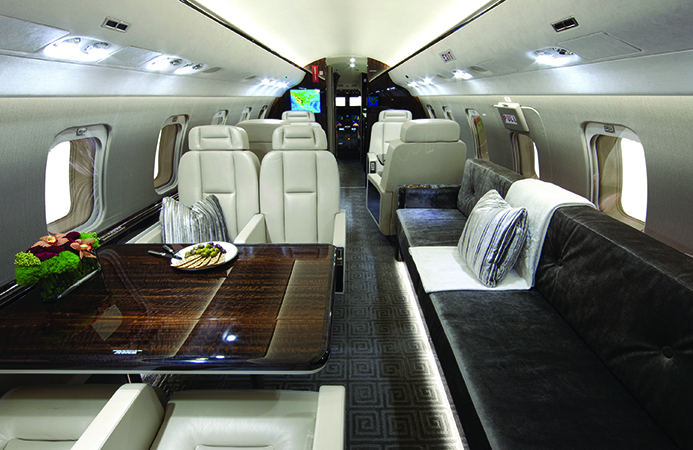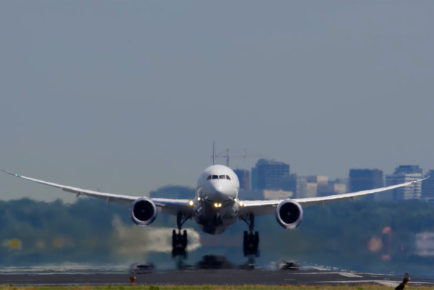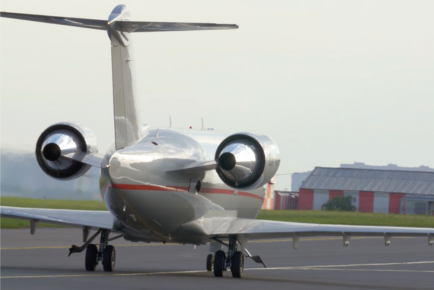
Download Article in PDF format
Some cabin considerations for operators
April 2013; World Aircraft Sales Magazine – Anyone who has traveled in a business jet knows cabin layout and design are almost as critical for operations as the cockpit and aircraft performance. When evaluating an aircraft for purchase or for lease, a lack of capability or an unsuitable configuration within the passenger compartment can quickly knock a specific model or serial number off the short list.
Aircraft manufacturers go to great lengths to provide up-to-date cabins. However they can quickly fall behind the trends of style and the ability to stay connected in a way that today’s passengers expect. Many service bulletins and software upgrades have circulated the world of OEM’s and MRO’s in order to try and stay abreast of change.
While not exhaustive, the decision map above highlights the diversity of interrelated factors in cabin options. Management pertains to cabin features that are controlled either manually or automatically and often by remote means. Each area of management in itself has many sub parts; for example environment relates to soundproofing, temperature, airflow and humidity control. Configuration pertains to what you see, the arrangement, and the level of comfort, access and safety. Each area of configuration in itself has subparts; for example Access + Mobility can have different concerns for in the air and on the ground.
The input side to the cabin options decision map represents the expectations of the operator who could be an individual owner, a corporate team, a management company and anything in between. Together, it’s a complicated process, and one that can greatly benefit by taking a higher-level perspective.
So let’s take the 30,000 ft. view, and look at the aspects of aircraft cabins that really matter to owners, buyers and sellers.
Obsolescence
Just like renovating a home in bold colors or customizing a car with a rear spoiler, it may suit the taste of the owner but would limit resale potential to a niche market. Choosing neutral blended designs and following general aircraft interior design guidelines will limit obsolescence.
The configuration of the cabin should follow what is standard for the aircraft or at least what buyers would expect for the model. Most importantly stay at least to the minimum seating capacity, and preferably, provide the ability to seat to the maximum for the type certificate, by providing a fully belted couch for example.
The cabin electronics and IT are the most susceptible to obsolescence. Think modular in your equipment to allow easy upgrades later. Provide easy access to audiovisual items for software revisions and adjustments. Manufacturers of these technologies are now ‘future proofing’ in an effort to be adaptable to changes as they occur.
‘Commercial off the shelf’ (COTS) products are renewed almost as often as seasonal clothing and appear dated quicker than you can imagine. Bear in mind support for COTS product is not what you have come to expect with equipment specifically designed and developed for aircraft. If an aircraft has any COTS cabin equipment, it is recommended to purchase back up units.
Buyers and seller expectations
My company, Jetcraft Corporation, trades corporate jets as its core business. When asked what today’s buyers and sellers are mostly focused on regarding the cabin, Sales Director Chris Brenner said it should be no surprise to learn that external communication and connectivity in general were key expectations. Most of today’s business jet transactions are of an international nature and many aircraft must be able to perform across different geographic regions including land, sea and polar.
Connectivity involves voice, data and video with a service provider to enable your link to satellites. In-flight entertainment (IFE) and “office in the sky” are the two big items for initial configuration and upgrade costs so there is a tendency to look for ways to save. Technology that uses Iridium satellites and is globalized for full international and polar coverage will typically cost less in both initial equipage and operating costs. Inmarsat satellites however have good data capability for international use. Make sure that cockpit needs such as FANS, weather and other operational services are considered when it comes to the selection of external communication equipment, as both the cabin and the cockpit may be using the same system(s).
Regarding the cabin appearance, Chris pointed out that as with any depreciating asset the return on investment for an upgrade may appear negative to both a seller and a buyer of a business jet. However the need to add, upgrade or “clean up” an interior in order to sell may be necessary. Sales professionals such as Jetcraft can advise on the need to make cabin changes in order to sell. Buyers may negotiate pricing on aircraft to offset their own cost to add necessary or desired cabin changes as an alternative approach.
Cabin management
Business jet cabin management varies from single seat manual control of lights to a monitor with icon based individual remotes controlling a host of cabin variables.
A few last minute cabin tips
With so many factors to consider regarding cabin design, it helps to have a few good places to start:
- When working on connectivity for initial and upgrade cabin design, make sure to involve your company IT department. Have the IT representative work closely with the aircraft technology OEM and the MRO to ensure and test communications protocol especially where secure IP and firewall protections are involved.
- Dedicate a laptop and a tablet computer for aircraft use to secure set up, capability, reliability and protection from unsecure Internet use out of the aircraft. Make sure the CEO and other leaders are familiar with them. If you have one or multiple aircraft use only one Service Set ID (SSID) or network name for the whole fleet, by design.
- Use neutral and coordinated colors and tones during cabin design. You may regret bold choices especially when it comes to selling the aircraft.
- Think closets, storage and access during cabin selection. Where does the CEO sit?
- Interview those who will be flying in the cabin before finalizing interior designs. You may have thought they needed an office when they only wanted a ‘mile high playroom’ for the teens.
Perhaps the most important step is to find a trusted aircraft interior designer, and an IT service provider who has the most experience with your communications, data and media configuration. This combination will more than pay for themselves by ensuring your satisfaction, and reliable and continuous connectivity as you circumnavigate the world.
SIGN UP FOR OUR MONTHLY JETSTREAM RECAP
Don't miss future Jetstream articles. Sign up for our Jetcraft News mailing list to receive a monthly eblast with links to our latest articles. Click to join the 1,800+ subscribers on our mailing list.





